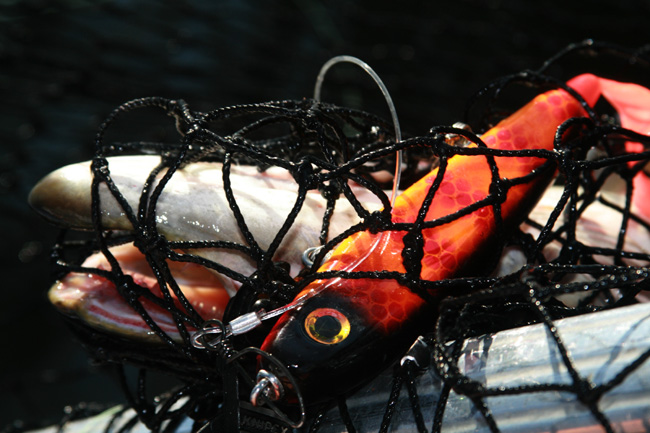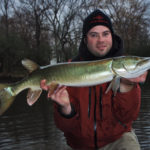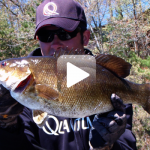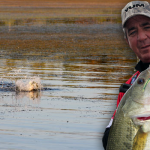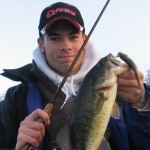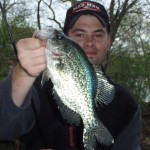By: Andrew Ragas – Date Posted: December 11, 2011
It was a cold and snowy February, 2011 morning. Not thrilled about going outside to shovel the snow, I woke up with the intentions of turning on the television. It seems that whenever I get the chance to watch any Saturday morning television, I turn on Comcast Sports or the Outdoor Channel. On this particular Saturday morning, I was excited to watch Jim Saric catch muskies on his television program, “The Musky Hunter.”
The subject of this particular show was fishing with gliders for early summer muskies. This was an interesting topic to say the least, and one that was such a coincidence and could not have come at a better time for me.
This episode captivated me because in the last few years, an increasing number of friends have been telling me that gliders aren’t just a late season lure for muskies. Rather, they catch fish during all times of the year. Unable to experience or witness this phenomenon for myself, at least I was going to see one of the most renowned musky anglers in the world put on a show on the television in front of me.
Mr. Saric indeed put on a show. I recall him and his partner boating a dozen muskies with Softail Phantoms on the Indiana lake they were fishing in early June.
For the longest time, I was skeptical about fishing with gliders. My perception of them was once old-school traditional, thinking that they only catch muskies during the cold water period when fish are actively feeding, but require slower presentations in order to catch.
After watching that one episode of “The Musky Hunter,” my perception of gliders immediately changed.
Introduction to Gliders
Gliders are characterized as “pull baits”. Their weight-forward design enables rocket-like casting, and while retrieved they feature a submerging side-to-side, walk-the-dog motion. They are lipless internally-weighted baits, made from either wood or hard plastic, that require slow to medium retrieve speeds accompanied by several jerks and pauses in between.
There is no wrong way to fish gliders as the action produced by the bait is generated entirely by the angler himself. This can be said for all baits and lures, but with gliders, the angler is in full control of the lure’s action and presentation. The action of the bait, matched accordingly to the moods and response of fish, will ultimately determine whether fish will be caught.

Lures for All Seasons
Gliders are weapons of choice for catching fish on a year-round basis. For instance, they perform as excellent search lures when fish are roaming the shallow flats and weedbeds. In these warmer water situations of late spring through mid-summer, and sometimes deep into summer, gliders can be fished fairly quickly for the purposes of covering water and searching for active fish. Besides being superb in shallower water, gliders are also effective with slower retrieval speeds and longer pause while fishing deeper water. Throughout the cold water period, gliders extract feeding fish along deep breaklines and open water.
For the first time in my brief musky angling career, gliders were a mainstay in my boat from late spring through middle of fall. I was so committed to the glider in 2011 that I had one rod rigged at all times with one. Not only were gliders diligently used on a daily basis, but during my lessons of self-educating, it was doing its fair share of catching as well.
My musky season typically begins during the Wisconsin opener in late May and runs until mid to late October. I wish it could go for longer until first ice but such is life. These five months of fishing encompass a plethora of seasonal changes and conditions. If I continue this discussion about what muskies are doing during each seasonal period in response to gliders, then I may as well write a book on it. However, to make a long story short, what’s needed to be known about gliders is they can be fished in all scenarios, and they catch fish year-round.

Gliders: How and When
The most important thing I want to generate from a glider is that when I retrieve it with pulls, jerks and pauses, I want it to glide from side-to-side with wild action. If I cannot generate the desired action or necessary response from fish when needed, then it is put away in favor of a different one. There is no sense in using something that doesn’t trigger a response from fish.
All gliders are not created equally as they are available in different shapes, sizes, designs, and weights. The density of the glider and its relationship to how it is crafted usually determines its overall performance, sinking ratio, and action in the water. However, anglers often have to make difficult choices on which styles or brands to use and in which situations to use them. In my opinion, experimentation with different baits until a level of comfort is formed, and the retrieve is mastered, is the best way to determine whether or not a particular lure should be fished.
There are several different glider styles in production, and each has its time and place. Some of my favorites and most-used gliders are produced by Phantom Lures, Slammer Tackle, Drifter Tackle, Smity, and Rapala.
Below is a quick summary of each glider I use, and the situations I find them to be the most effective:
Softail Phantom: Of all gliders I use, softails are my absolute favorites. They can be fished fast or slow in all conditions and any situations. They feature an enticing plastic tail whose action is irresistible to fish. The Phantom is considered to be one of the easiest gliders to use for both experienced and beginner anglers alike. Its easy and wide side to side action accompanied by its roll at the end of each glide produces an incredible action and belly flash. According to experts, the belly flash is a proven triggering mechanism on getting muskies to strike. This is an excellent crossover lure between hard baits and soft baits and I would be lost on the water without one. I exclusively use the 6” 2 ¾ oz. model and have one rigged on a rod at least 75% of the time. In 2011, the “Canadian Crush” pattern quickly became a confidence lure. In my opinion, softails simply raise fish and catch them when nothing else can!

Slammer Drop Belly: This shad style bait is one of my all time favorites, and it is used on a year round basis in almost all situations. The only thing missing from it is a soft plastic tail, but due to its wicked action it can get away without one. This is quite possibly one of the easiest gliders to use as minimal involvement is required in order to make it work properly. This is one of the best options for anyone who is new to fishing with gliders. In fact, this was the first glider I ever purchased and used. The drop belly is weighted for neutral buoyancy and hangs longer in the strike zone than any glider I have ever used. This bait is masterfully created from a solid plastic body and features beautiful paint patterns with a super tough clear coat protection.
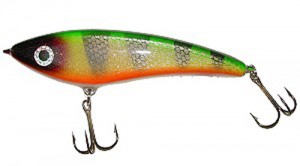
Drifter Hellhound: The Hellhound is one of the best constructed and durable plastic baits I have ever fished with. At 8” and 3.8 oz., it is easy to use and versatile as it can be fished slow or erratic. I prefer using the Hellhound during the fall months when fish are likely to be caught in deeper water situations, and when fast erratic action is not required.

Smity Power Glide: Smity’s Powerglide is a relic of a lure, and a pioneer in musky fishing. At 7” and 3.1 oz., it features a great sweeping side-to-side action in a countdown glider. The bait sinks at a rate of about a half a foot per second. A short downward tap with the rod will usually get this hardwood lure dancing in front of fish. I prefer using the Powerglide again in the fall when fish are feeding along deeper breaklines.

Rapala Glidin’ Rap: The Glidin’ Rap is a wide profiled wooden bait that glides side to side just below the surface and stays within the strike zone. This bait features an indestructible finish with lazer sharp hooks, and is best fished with rod tip faced down and twitching it in a walk-the-dog method. I exclusively fish with its 1.8 oz. 5 ½” model during post-frontal conditions, high skies, and when downsizing is needed. Worked with a heavy flipping stick that is better equipped for big bass or pike fishing, I can really make this lure dance a lot in the water with lighter tackle. It seems to wake fish up when nothing else can.

Getting Equipped
Gliders are a large part of today’s musky world and it is important to be equipped with the proper rods and reels. Nowadays, rods and reels have turned into technique-specific tools that enhance the musky fishing experience.
Several modern-day rod manufacturers have delivered on the demand of technique-specific rods. Rods are now available in longer and more durable blanks that are comfortable to use and more efficient at properly presenting baits and catching fish.
For all purpose jerkbait and glider fishing, it is recommended to use rod lengths of 6 ½ feet to 7 ½ feet long. Since I am a bigger and stronger guy with all the stamina in the world to fish, I prefer fishing with longer rods. I use a 7 ½ footer medium extra heavy fast action rod for all of my glider fishing. It possesses minimal bend with a lot of power. The rod in particular is an extremely affordable and durable Shimano Compre equipped with a Shimano Curado 300DSV low profile reel that allows me to fish comfortably without any fatigue.
This set-up has a number of additional benefits besides its comfort and profile. First and foremost, the rod enables accurate casting which is important to fishing with gliders. Secondly, the rod’s length gives me a greater reach with figure-8’s. Lastly, its heavier fast action allows me to fish with whatever glider sizes and styles I desire, and no matter what design I am using, it seems to aid in making all baits be presented properly. Coupled with my retrieve techniques, a comfortable rod that imparts action on the bait is critical to success.
Besides choosing the proper rod, getting equipped with the right reel and line is also important. Due to the erratic pulling and jerking retrieves needed for glider fishing, using a reel with a faster gear ratio is the best. I am not partial to any reel manufacturers, so the best advice I can offer is that anything that falls into your budget, is comfortable, and enables you to keep up with the slack line is the best option. As for line selection, at least 65lb. braided superline is recommended and I strictly use 80lb. Cortland Masterbraid as it is the most durable and smoothest-casting line I have ever used.
Leaders are another important component to also consider. For glider fishing, should I use single strand wire? How about invisible fluorocarbon, or what about action-packed, flexible and memory-free titanium leaders?
In my opinion, leaders don’t make much of a difference, but what you elect to use greatly dictates the type of lure action that will be generated. For general-purpose glider fishing, a single strand wire leader is recommended as it is the strongest and most durable. However, if erratic action is desired, I have been able to get away by using fluorocarbon and titaniums. The latter seems to bring out the best in each bait for me.

Conclusion
It was a mere five years ago when I turned serious and committed myself to catching muskies. Amongst every lesson I’ve learned through trial and error, and the information and knowledge that I’ve gained from educators and experts, I’ve found that having a willingness to try new techniques and to be persistent with them is one of the biggest successes in putting fish in the net.
Moral of the story is that unconventional thought and a willingness to try new techniques and applying them during all seasons will ultimately catch more fish.
In the case of using glide baits for year-round purposes, I finally understood what my friends were telling me, and what Mr. Saric was trying to prove on television. Gliders really do work during all seasons!



